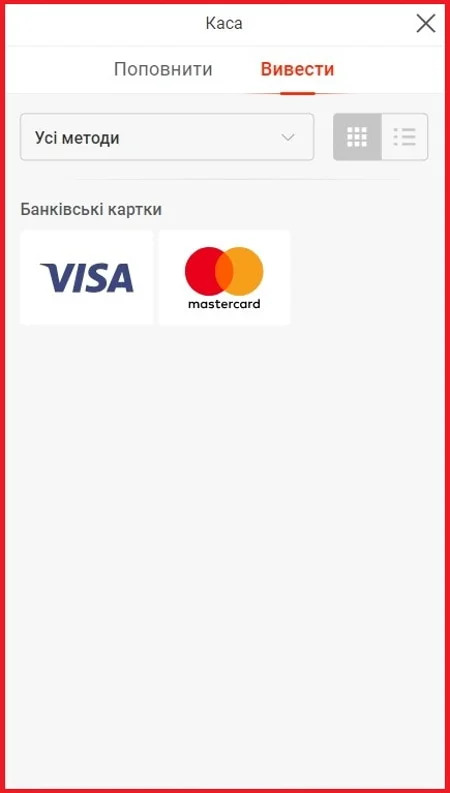Pin-Up (Пін-Ап) виведення коштів
Українське онлайн казино Пін Ап працює за ліцензією КРАІЛ та пропонує лише сертифіковані азартні ігри, які працюють на ГВЧ. Вигравати у 100% випадках гравці не можуть, однак середній показник віддачі слотів у 96% дає непогані шанси на отримання винагороди. Pin Up гарантує чесний ігровий процес та своєчасну виплату грошей. Але останнім часом все частіше перед відвідувачами постає питання: Як вивести кошти з Пін Ап.

Чому не працює Pin-Up?
Причин, з яких не працює Пін Ап, може бути декілька:
- Технічні проблеми на офіційному сайті казино або платіжної системи.
- Pin Up не працює, бо спостерігаються проблеми з інтернет-з’єднанням гравця. Треба звернутись до свого провайдера.
- Доступ к облікового запису гравця обмежений за порушення правил. Це питання слід поставити оператору технічної підтримки.
- Шукаючи причину, чому не працює Пін Ап, слід перевірити, можливо доступ до казино блокує антивірус. У цьому випадку рекомендується його ненадовго вимкнути.
- Пін Ап не працює з причини порушення налаштувань DNS сервера.
- Обмеження доступу до Pin Up, бо відвідувач знаходиться у країні, юрисдикція якої забороняє азартні ігри. У цьому випадку слід скористатись дзеркалом, VPN тощо.
Тобто перш ніж звертатись у техпідтримку, щоб з’ясувати чому не працює Пін Ап в Україні, треба перевірити, чи проблема дійсно у казино.
Як вивести кошти з Пін-Ап?
З Pin Up вивести гроші можна лише за умови дотримання певних правил:
- обліковий запис повинен бути верифікованим;
- депозит та зняття коштів відбуваються з використанням одного рахунку, який належить гравцеві;
- перед тим, як подати заявку на кешаут, слід зробити хоча б одну ставку.
Покрокова інструкція як вивести гроші з Пін Ап:
- Авторизуватись на сайті казино. Ввести логін та пароль.
- Зайти у розділ «Каса». Розташований вгорі облікового запису.
- Перейти у «Виведення».
- Обрати платіжну систему. Раніше з неї повинен бути здійснений депозит.
- Вказати суму.
- Підтвердити переказ грошей, вказавши смс-код.
Слід врахувати, що Пін Ап є ліцензійним казино та утримує податок з виграшів при виводі. Мінімальний кешаут — 100 грн.
Що робити, якщо ви не можете вивести гроші?
Деякі гравці стикаються з труднощами при виводі та задаються питанням, чому не працює Pin-Up. У цьому випадку пропонується декілька кроків, які дозволять здійснити з Пін Ап вивід грошей.
Звернення в техпідтримку
Це перше, що повинен зробити гемблер у разі виникнення проблем. Спитати чому не працює Пінап можна цілодобово в онлайн чаті на офіційному сайті. Оператори відповідають протягом хвилини. Також відвідувачам пропонується написати запит на емейл або подзвонити телефоном. Додатково зв’язатись із саппортом пропонується у групах соцмереж — Телеграм, Інстаграм, Х.
Перевірте верифікацію акаунта
Нерідко трапляються випадки, що гемблер просто забув пройти верифікацію. Це обов’язковий крок для того, щоб мати змогу вивести гроші. Ідентифікація доступна у персональному кабінеті. Гравцеві необхідно надіслати копію одного з документів, що посвідчують особу, або пройти перевірку за допомогою застосунку «Дія».
Перевірка правил і умов
Перед тим, як зареєструватись та здійснювати фінансові транзакції необхідно познайомитись з правилами грального закладу. Азартні ігри та вивід коштів заборонені неповнолітнім. Також не можна створювати більше одного профілю. Деякі бонуси та участь в акціях мають додаткові обмеження виводу до моменту відіграшу отриманих виграшів. Більше інформації гравці знайдуть на офіційному сайті або дізнаються у оператора саппорта.
Виберіть надійний платіжний метод
Ліцензійне казино Пін Ап співпрацює лише з перевіреними платіжними системами України:
- Банківські картки Visa і Mastercard;
- Apple Pay Google Pay;
- City;
- Easy Pay.
Для виводу слід обрати ту саму платіжну систему, з якої був здійснений депозит. Якщо гемблер бажає змінити платіжний метод, то спершу треба поповнити рахунок.
Обмежте суму виведення
Розбираючись у питанні, Пін Ап чому не працює, треба спробувати знизити суму, яка поставлена на вивід. Може розмір виплати не відповідає встановленим лімітам.
Переваги гри у Пін Ап
| Плюси | Мінуси |
| ✅ Наявність ліцензії КРАІЛ | Вейджер для бонусів |
| 📞 Цілодобова підтримка клієнтів | Тривала верифікація |
| 🎨 Яскравий дизайн сайту | |
| 🎁 Щедрі бонуси | |
| 🎰 Більш ніж 6000 слотів | |
| 🏆 Якісна програма лояльності | |
| 💬 Велика кількість позитивних відгуків | |
| 🎉 Наявність бездепозитних бонусів | |
| 📱 Застосунок для Андроїд та iOS, мобільний сайт | |
| 🔒 Чесні умови гри, захист гравців | |
| ⚡ Швидкі виплати |
Висновок
Pin-Up — це одне з кращих легальних гральних закладів України, яке отримало позитивні відгуки від шанувальників азарту та гарну репутацію. Якщо у казино виникають проблеми з виводом, то труднощі швидко вирішуються цілодобовою підтримкою.
FAQ
🔉 Що робити якщо я не можу зайти на сайт Пін Ап?
У вас є 2 варіанти — це скористатись VPN дзеркалом сайту.
🔉 Де знайти актуальне, офіційне дзеркало Пін Ап?
Ви його можете самостійно запросити у техпідтримки, знайти на сайтах-партнерах, групах соцмереж тощо.
🔉 Чому Пін Ап усе частіше блокується у регіонах України?
Причина у тому, що керівництво закладу підозрюється у зв’язках з рф.
🔉 Що робити, якщо в мене заблокований вивід коштів?
Це можуть бути проблеми технічного характеру, проблеми з підключення до інтернету, обмеження доступу до облікового запису тощо. З’ясувати причину допоможуть оператори служби підтримки.